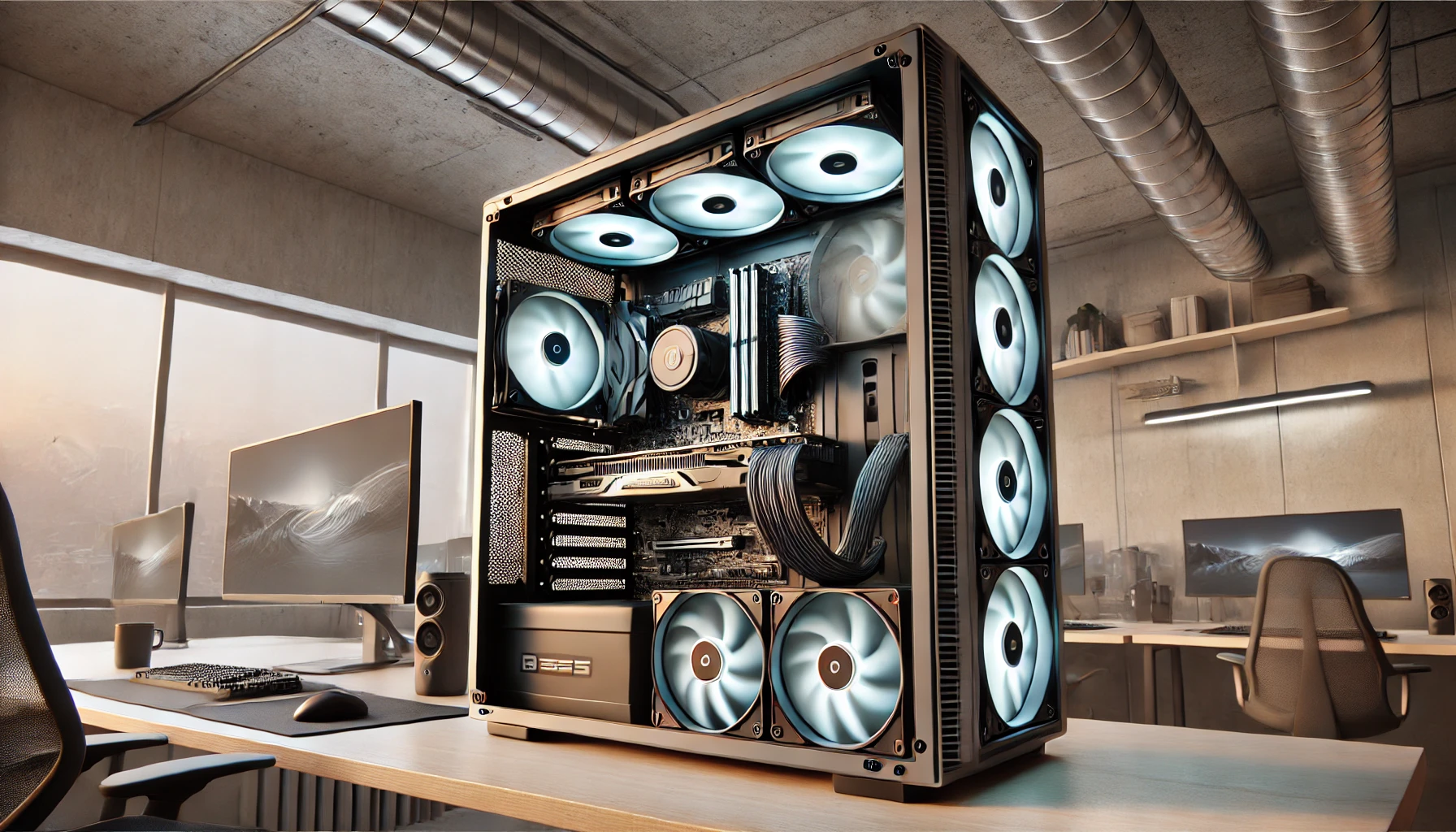Many PC builders prioritize performance, but noise and airflow are just as important—especially if you value comfort, silence, or plan to work and game for hours at a time. In 2025, you no longer have to choose between cooling and silence. With smart choices and good planning, you can build a PC that’s powerful, quiet, and stays cool under pressure.
In this guide, you’ll learn how to build a silent and well-ventilated PC, with practical tips on choosing components, optimizing airflow, and minimizing fan noise.
Why a Quiet and Cool PC Matters
- Less distraction while working or gaming
- Longer component lifespan thanks to lower temps
- Better focus and comfort in quiet environments
- No annoying fan ramp-ups during multitasking or gaming
Whether you work in an office, stream, or just dislike fan noise, a silent build improves your experience.
1. Start with a Good Case
Your case sets the foundation for airflow and noise control.
Features to look for:
- High airflow design (mesh front panels, vented top)
- Sound-dampening materials (foam padding inside panels)
- Anti-vibration mounts for fans and drives
- Room for large, quiet fans and coolers
- Cable management space to reduce airflow obstruction
Recommended case styles:
- Be Quiet! Silent Base series
- Fractal Design Define or Meshify
- NZXT H series with airflow improvements
💡 Choose a mid or full-tower for better airflow and less heat buildup.
2. Use Larger, Slower-Spinning Fans
Fan noise comes from fast-spinning, small-diameter fans. Replace them with larger, quieter ones.
Best options:
- 120mm or 140mm fans with fluid dynamic or magnetic bearings
- Run fans at low RPM (600–1000 RPM for intake/exhaust)
- Consider PWM-controlled fans to adjust speed dynamically
- Noctua, be quiet!, Arctic, and Phanteks make some of the quietest fans available
💡 More fans at low speed = better airflow and lower noise than fewer fans spinning fast.
3. Optimize Airflow Direction
Keep airflow simple and consistent:
- Front/bottom = intake (cool air in)
- Top/rear = exhaust (hot air out)
- Use dust filters on intakes
- Ensure positive pressure (slightly more intake than exhaust) to prevent dust buildup
Avoid mixing directions or blocking air paths with cables or large GPUs.
💡 Use your case’s built-in fan filters and clean them every 1–2 months.
4. Choose a Quiet CPU Cooler
Stock coolers are functional but often noisy. Upgrading to a quiet air cooler or AIO makes a huge difference.
Best choices:
- Large tower air coolers (Noctua NH-U12A, be quiet! Dark Rock Pro 5)
- 120mm or 240mm AIOs with silent pump and fans (NZXT, Arctic Liquid Freezer II)
- Ensure proper installation and good thermal paste application
💡 Avoid tiny coolers in compact cases unless using a low-wattage CPU.
5. Select a Silent or Semi-Passive GPU
Some GPUs now feature 0dB modes, where the fans stop spinning entirely under light use.
- Look for “silent” BIOS modes or fan-stop features
- Triple-fan GPUs with larger heatsinks usually run quieter
- Brands like ASUS TUF, MSI Gaming X, and Gigabyte Windforce focus on silent operation
💡 For silent PCs, avoid blower-style GPUs—they’re louder and less efficient.
6. Use a Semi-Passive or Silent PSU
Many modern PSUs only spin their fan under heavy loads.
- Look for semi-passive or fanless designs
- Choose 80+ Gold or Platinum for higher efficiency and less heat
- Brands: Seasonic, Corsair RMx, Be Quiet!, EVGA SuperNOVA
💡 Higher efficiency = less heat = less fan noise.
7. Use SSDs Instead of HDDs
Traditional hard drives create vibrations and mechanical noise.
- Use NVMe or SATA SSDs for your OS and main storage
- If you need HDDs for bulk storage, use them in anti-vibration trays
- Spin-down HDDs when not in use (configurable in power settings)
💡 SSDs are completely silent and much faster.
8. Manage Your Fan Curves
Use BIOS or software tools to create custom fan profiles.
- Set low fan speeds under 50°C
- Increase only gradually beyond that point
- Use software like:
- Fan Control (open source)
- MSI Dragon Center / ASUS Fan Xpert / Gigabyte EasyTune
💡 Fine-tuning fan curves is the easiest way to cut noise without losing cooling performance.
9. Organize Cables for Better Airflow
Poor cable management blocks airflow, making fans work harder (and louder).
- Use case cable channels and Velcro straps
- Route behind the motherboard tray
- Keep cables away from fans and air channels
💡 Clean airflow = lower temperatures = quieter fans.
10. Reduce Vibration Noise
Small things make a difference:
- Use rubber fan mounts
- Anti-vibration grommets for PSU and hard drives
- Secure all panels and components tightly
- Place the PC on a solid surface, not a hollow desk or shelf
💡 Vibration noise can resonate through furniture if not controlled.
Final Thoughts
A quiet and well-ventilated PC is possible in 2025 without sacrificing power. By choosing efficient, low-noise components and optimizing your build layout, you can enjoy a cool, near-silent machine whether you’re working, gaming, or editing video.
Focus on airflow paths, low-RPM fans, and premium cooling solutions—and your ears will thank you.
